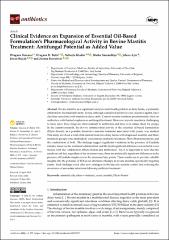Clinical Evidence on Expansion of Essential Oil-Based Formulation’s Pharmacological Activity in Bovine Mastitis Treatment: Antifungal Potential as Added Value

View/
Date
2024Author
Tomanić, Dragana
Božić, Dragana D.
Kladar, Nebojša
Samardžija, Marko
Apić, Jelena
Baljak, Jovan
Kovačević, Zorana
Metadata
Show full item recordAbstract
Bovine mastitis, as a significant and prevalent health problem in dairy herds, is primarily
attributed to bacterial infections. Yeasts, although considered relatively rare causative agents, have
also been associated with mastitis in dairy cattle. Current mastitis treatment predominantly relies on
antibiotics, with limited emphasis on antifungal treatment. However, mycotic mastitis is challenging
to treat, since these fungi are often resistant to antibiotics and may even utilize them for energy.
In the current research, the in vivo antimicrobial activity of the essential oil-based formulation
(Phyto-Bomat), as a possible alternative mastitis treatment associated with yeasts, was studied.
This study involved a total of 68 animals from two dairy farms with diagnosed mastitis, and three
treatment groups were established: conventional antibiotic treatment, Phyto-Bomat treatment, and
the combination of both. The findings suggest significant variations in the presence of Candida
samples based on the treatment administered, and the most significant difference was noted in cows
treated with the combination (Phyto-Bomat and antibiotics). Yet, it is important to note that the
results reveal that, regardless of the treatment type, there are statistically significant differences in the
presence of Candida samples across the examined time points. These results aim to provide valuable
insights into the potential of EOs as an alternative therapy in bovine mastitis, specifically targeting
yeasts. Such findings could offer new strategies in the mycotic mastitis control and reducing the
occurrence of secondary infections following antibiotic treatment.
